

Taxonomie de Bloom. Un article de Wikipédia, l'encyclopédie libre.

La roue de la taxonomie de Bloom. La taxonomie de Bloom est un modèle pédagogique proposant une classification des niveaux d'acquisition des connaissances[1]. Benjamin Bloom, bien qu'il n'en soit pas le seul créateur (34 universitaires américains participent aux conférences de 1949 à 1953), est souvent reconnu comme le « père » de cet outil[2],[3]. Description[modifier | modifier le code] Taxonomía de Bloom – Esquema para Redactar Competencias. Conferencia para Universidad César Vallejo, Perú Conferencia para Aulas Telefónica, México.
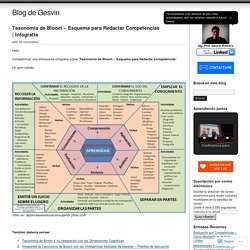
La taxonomía de Bloom: ¿hablamos? (1/2) Hace tiempo que tengo interés en escribir sobre este tema que tiene tanta trascendencia en el proceso de aprendizaje y enseñanza.
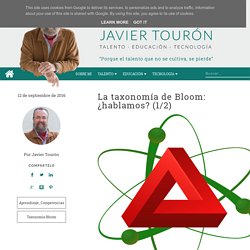
Ya lo hice indirectamente en las entradas sobre el establecimiento de estándares (1, 2 y 3), también al ofrecer algunos recursos como la entrada sobre Bloom y el inglés, o aquella sobre el iPad, la Web 2.0 y Pinterest en la que, por cierto, se incluye una presentación de Slideshare muy interesante con docenas de representaciones diversas de la taxonomía. Finalmente quiero citar otra que titulé: ¿Quieres dominar la taxonomía...? Esta última es fantástica para una sesión de trabajo con profesores por ejemplo, en particular la herramienta que en ella se presenta para faciliatr la formulación de objetivos según los niveles de la taxonomía. Bueno ahora quiero volver a lo básico. Si tuvieses que definir un objetivo de aprendizaje, ¿cuál sería tu definición? "Un objetivo es la expresión de un resultado deseado, previsto y, al menos en parte, alcanzable" D.
TaxonomieDeBloom:Accueil. Taxonomía de Bloom – Esquema para Redactar Competencias. Taxonomía de Bloom – Verbos para la Identificación de Competencias. Blog de Gesvin "Si enseñamos a los alumnos de hoy como enseñábamos ayer les estamos robando el futuro" – J.

Dewey Taxonomía de Bloom – Verbos para la Identificación de Competencias | Infografía leave a comment » Hola: A New Visual On Bloom's Taxonomy for The Web. La taxonomía SOLO de Biggs. Home. Blooms Digital Taxonomy for Android. November 4, 2015 Blooms traditional taxonomy which was published sometime in the middle of the last century was revised in 2001 and henceforth was labelled Blooms Revised Taxonomy.

This revision is a little bit different from the original one in that it replaces nouns with verbs and places emphasis on the process of creating by putting it on the top of the thinking continuum. With the emergence of web 2.0 tools and mobile apps, Bloom's Revised Taxonomy has been re-adapted to incorporate the digital element within it. One of the major contributors to this shift is Andrew Churches whose wiki page features some primer resources on what comes to be labelled Bloom's Digital Taxonomy.
New Bloom's Taxonomy Poster for Teachers. August 29, 2014 Bloom's taxonomy is one of the most popular learning taxonomies ever.
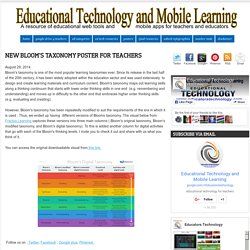
Since its release in the last half of the 20th century, it has been widely adopted within the education sector and was used extensively to design and create learning materials and curriculum content. Bloom's taxonomy maps out learning skills along a thinking continuum that starts with lower order thinking skills in one end (e.g. remembering and understanding) and moves up in difficulty to the other end that embraces higher order thinking skills (e.g. evaluating and creating).
However, Bloom's taxonomy has been repeatedly modified to suit the requirements of the era in which it is used . Thus, we ended up having different versions of Blooms taxonomy. Bloom's Digital taxonomy v3.01. 01 taxonomías de resultados de aprendizaje Bloom y Biggs. 08 taxonomías de resultados de aprendizajes que nos ayudan a diseñar … La taxonomía de Bloom: aplicación a la didáctica de las Ciencias Sociales.
Conectando el Modelo SAMR y la taxonomía de Bloom. Taxonomie_BLOOM.pdf. A New Wonderful Wheel on SAMR and Bloom's Digital Taxonomy. The buzz that the Modern Taxonomy Wheel generated over the last couple of weeks has not yet died out and now we have a new updated wheel from the same guy Allan Carrington.
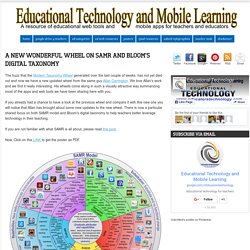
We love Allan's work and we find it really interesting. His wheels come along in such a visually attractive way summarizing most of the apps and web tools we have been sharing here with you. If you already had a chance to have a look at the previous wheel and compare it with this new one you will notice that Allan has brought about some new updates to the new wheel. There is now a particular shared focus on both SAMR model and Bloom's digital taxonomy to help teachers better leverage technology in their teaching. If you are not familiar with what SAMR is all about, please read this post. Now, Click on this LINK to get the poster as PDF. La taxonomie des objectifs pédagogiques - MindMeister Mapa Mental. La taxonomie de Bloom à l'heure numérique. A Bloom's Digital Taxonomy For Evaluating Digital Tasks.
A Bloom’s Digital Taxonomy For Evaluating Digital Tasks by TeachThought Staff What makes Bloom’s Taxonomy such a power tool is its flexibility in framing almost anything–which is why you’ve been seeing a lot of it around lately, and will likely continue to.
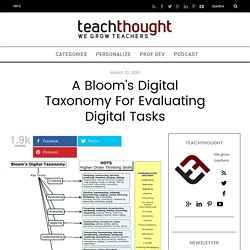
Whether you’re creating a checklist for instructional design, evaluating an assessment, skimming a favorite unit of yours, or using it as a walk-through instrument to get a feel for the level of student thinking in a classroom, Bloom’s Taxonomy is a powerful tool for any educator at any level. So the following Bloom’s Digital Taxonomy was was especially interesting in how it mashes digital tasks–podcasting, blogging, networking, hacking, bookmarking, social media sharing, and so on, with the stalwart learning tool so graciously delivered by Benjamin Bloom. Taxonomía de Bloom para la era digital. La taxonomía cognitiva de Bloom, clasifica las operaciones cognitivas en seis niveles de complejidad crecientes (recordar, entender, aplicar, analizar, evaluar y crear).
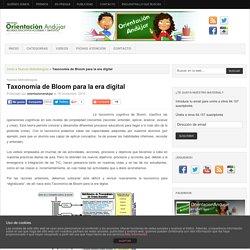
Esta teoría permite conocer y desarrollar diferentes procesos educativos para llegar a lo más alto de la pirámide (crear). Con la taxonomía podemos saber las capacidades adquiridas por nuestros alumnos (por ejemplo, para que un alumno sea capaz de aplicar conceptos, ha de poseer las habilidades inferiores: recordar y entender). Los verbos empleados en muchas de las actividades, acciones, procesos y objetivos que llevamos a cabo en nuestras prácticas diarias de aula. Pero no atienden los nuevos objetivos, procesos y acciones que, debido a la emergencia e integración de las TIC, hacen presencia tanto en nuestras vidas y en las de los estudiantes, como en las clases e, incrementalmente, en casi todas las actividades que a diario acometemos. PODEMOS AÑADIR la Pirámide de Bloom de Samantha Penney Fuente: fuente: Relacionado. TaxonomiadeBloom. La taxonomía de Bloom para la nueva Era Digital -Orientacion Andujar.
Han pasado más de cincuenta años y la Taxonomía de Bloom continúa siendo herramienta fundamental para establecer objetivos de aprendizaje.
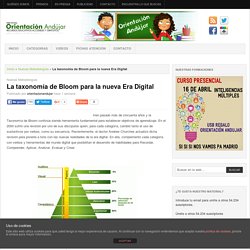
En el 2000 sufrió una revisión por uno de sus discípulos quien, para cada categoría, cambió tanto el uso de sustantivos por verbos, como su secuencia. Recientemente, el doctor Andrew Churches actualizó dicha revisión para ponerla a tono con las nuevas realidades de la era digital. En ella, complementó cada categoría con verbos y herramientas del mundo digital que posibilitan el desarrollo de habilidades para Recordar, Comprender, Aplicar, Analizar, Evaluar y Crear.
Relacionado. La taxonomie de Bloom. Taxonomie de bloom. Bloom's Digital Taxonomy Cheat Sheet for Teachers. The Best Resources For Helping Teachers Use Bloom’s Taxonomy In The Classroom. Bloom’s & SOLO ‘are not Just Colorful Posters we Hang on the Wall’ is my two-part series at Education Week Teacher. Bloom’s Taxonomy is talked about a lot in educational circles. However, if you believe a recent survey of visits to 23,000 U.S. classrooms, the higher-order thinking skills it’s ideally designed to promote doesn’t get much use. And I can understand why. It’s easy to get caught-up in the day-to-day work involved in teaching a class or multiple classes, and it’s easy to fall into the trap of doing the “usual stuff” and not “think out of the box.” I thought it might be useful to share in a “The Best…” list the resources that help me try to use Bloom’s Taxonomy in my classroom. There may very well be resources out there that do a far better job of explaining the Taxonomy and how to use it.
Clickerquestions / Bloom's Taxonomy. This page contains some fairly dry background on Bloom's taxonomy. For exciting ideas on how to write clicker questions at each level of the Taxonomy click here. Bloom’s Taxonomy and higher order thinking Bloom’s taxonomy of educational objectives is a framework for categorizing educational objectives. First published in 1956 it has provided a basis for test design and curriculum development throughout the world (Anderson and Krathwohl, 2001). The original taxonomy consisted of six educational objectives arranged in a cumulative hierarchy from the simple to the complex: kno wledge, comprehension, application, analysis, synthesis and evaluation. Applications of the taxonomy Since its publication, Bloom’s taxonomy has been widely used by curriculum planners, administrators, researchers and classroom teachers at all levels of education (Bloom, 1994).
Viser plus haut : Bloom et Vygotski dans la classe. La taxonomie d'Anderson et de Krathwohl. Great Web Tools for Bloom's Digital Taxonomy. After posting yesterday's graphics on Blooms Taxonomy I got emailed this wonderful presentation on the same topic. I was really surprised I did not see it before especially knowing that it is a popular presentation with over 60.000 pageviews. This Prezi is created by Phillipa Cleaves ( project manager- Technology for Learning and Digital Education Revolution, NSW department of education and communities ) and features the six thinking skills of Bloom's Taxonomy: remembering, understanding, applying, analyzing, evaluating, and creating . Under each skill is a set of web tools that go with it, clicking on any title will direct you to the homepage of that tool.
I have gone through Phillipa's slides and I must say that it is really a great work that I am adding to my Bloom's Taxonomy for Teachers section here in Educational Technology and Mobile Learning. Web Tools to Use with Bloom's Digital Taxonomy. Définir des objectifs pédagogiques efficaces et cohérents grâce à la taxonomie de Bloom et la méthode SMART.
Une fois les besoins et attentes de formation analysés, définir vos objectifs pédagogiques constitue une étape fondamentale dans le développement de votre projet de formation. C’est le message que j’avais tenté de faire passer dans l’article de lundi : cette étape vous permet non seulement de baliser votre parcours, et aussi d’en faciliter l’évaluation. Toutefois il n’est pas toujours évident de définir facilement ses objectifs pédagogiques : quelles formulations utiliser ? Faut-il nécessairement intégrer des verbes d’action ? Comment vérifier que les objectifs soient effectivement opérationnels ? …